Floridaseeds
Manchurian Catalpa Catalpa bungei 100 Seeds USA Company
Manchurian Catalpa Catalpa bungei 100 Seeds USA Company
Couldn't load pickup availability
Catalpa bungei, commonly known as the Chinese catalpa or Manchurian catalpa, is a deciduous tree native to China and Korea. Here's a description of its key features:
Size and Shape: Catalpa bungei is a relatively small to medium-sized tree, typically reaching heights of 6 to 12 meters (20 to 40 feet). It has a rounded or spreading crown with a symmetrical shape.
Leaves: The leaves of Catalpa bungei are large, heart-shaped, and glossy green. They are arranged in pairs or whorls along the branches and have prominent veins. The leaves turn yellow in the fall before dropping in preparation for winter.
Flowers: In late spring to early summer, Catalpa bungei produces showy clusters of fragrant, trumpet-shaped flowers. The flowers are white with purple or yellow markings and have a pleasant fragrance. They attract pollinators such as bees and butterflies.
Fruit: After flowering, Catalpa bungei develops long, slender seed pods that resemble beans. These pods are typically 20 to 40 centimeters (8 to 16 inches) long and contain numerous small seeds.
Bark: The bark of Catalpa bungei is smooth and gray when young, developing furrows and ridges as the tree matures.
Habitat: Chinese catalpa trees prefer full sun and well-drained soil. They are adaptable to a range of soil types but thrive in moist, fertile soils. They are commonly found in gardens, parks, and urban landscapes.
Landscaping and Uses: Catalpa bungei is often planted as an ornamental tree for its attractive foliage, flowers, and overall aesthetic appeal. It is also valued for its fast growth rate and ability to provide shade. Additionally, the wood of Catalpa species is sometimes used for making furniture, fence posts, and other wooden products.
Hardiness: Catalpa bungei is generally hardy and tolerant of a variety of growing conditions. It can withstand occasional drought once established and is relatively resistant to pests and diseases. Hardy in zones 5-9.
Growing Instructions for the Manchurian Catalpa
The seeds need to be planted when received or stored in a refrigerator until they are planted. The seeds have a period of dormancy. They can be planted in the fall for spring germination or they can be cold stratified to simulate winter conditions and to break their dormancy. The seeds are stored in a refrigerator so they have already been stratified. 1. Soak the seeds in water for 24 hours. 2. Fill a pot with a mixture of potting soil and sand, peat moss or vermiculite. The seeds need moist, well-drained soil. Use pots that have drainage holes in the bottom. 3. Sow the seeds on the soil and cover them with a thin layer of soil. 4. Water the container and leave it to drain. 5. Put the pot in a warm, sunny area. 6. Water the pot regularly so that the soil is moist but not wet.
Materials
Materials
Shipping & Returns
Shipping & Returns
Dimensions
Dimensions
Care Instructions
Care Instructions
Share








